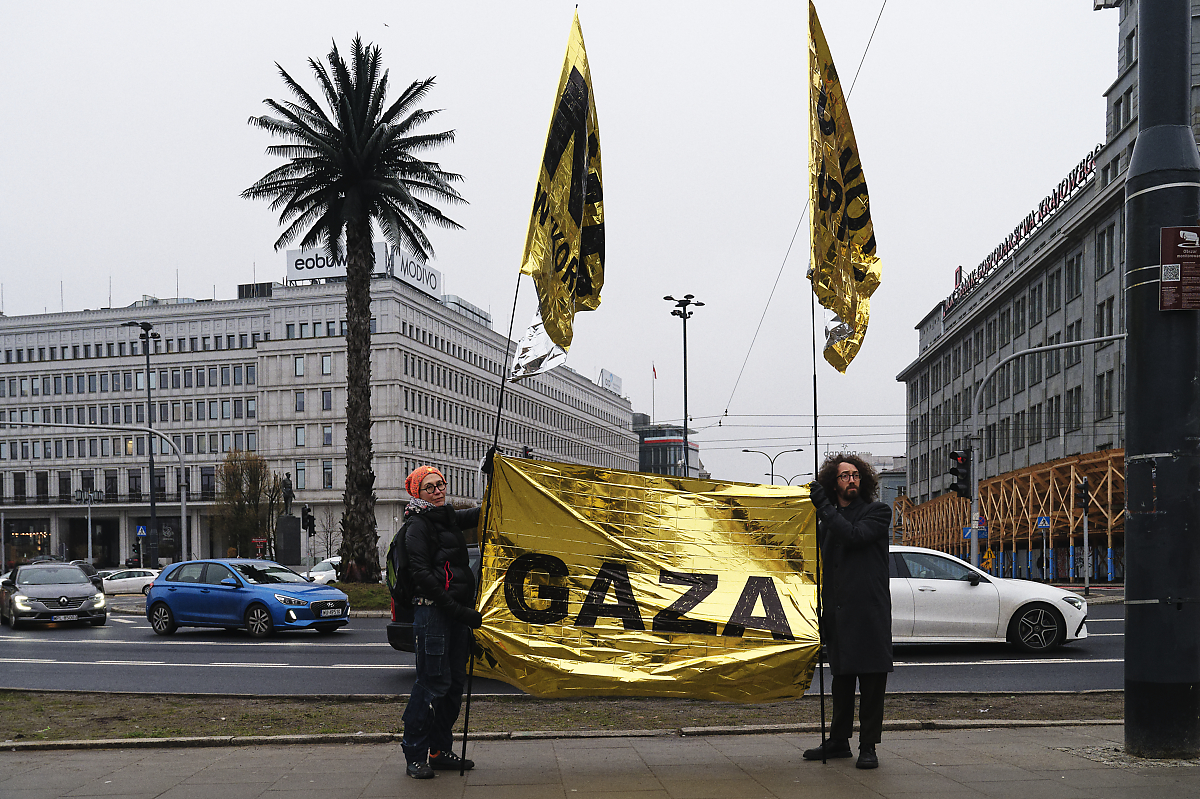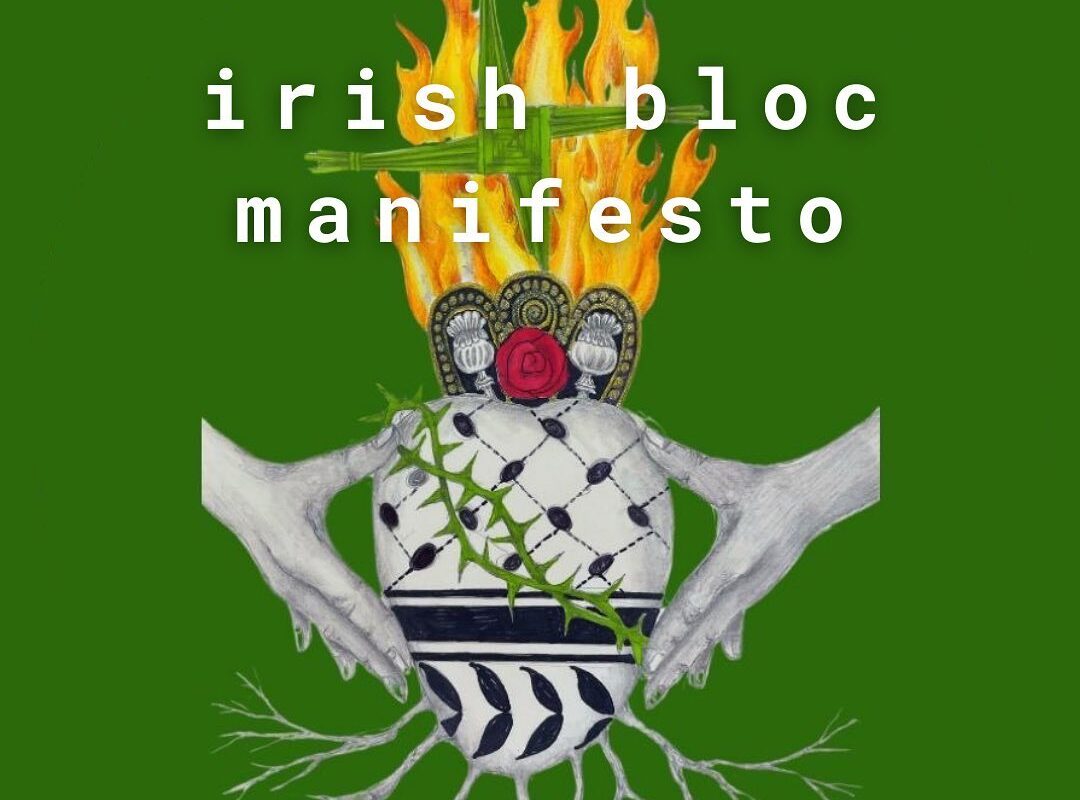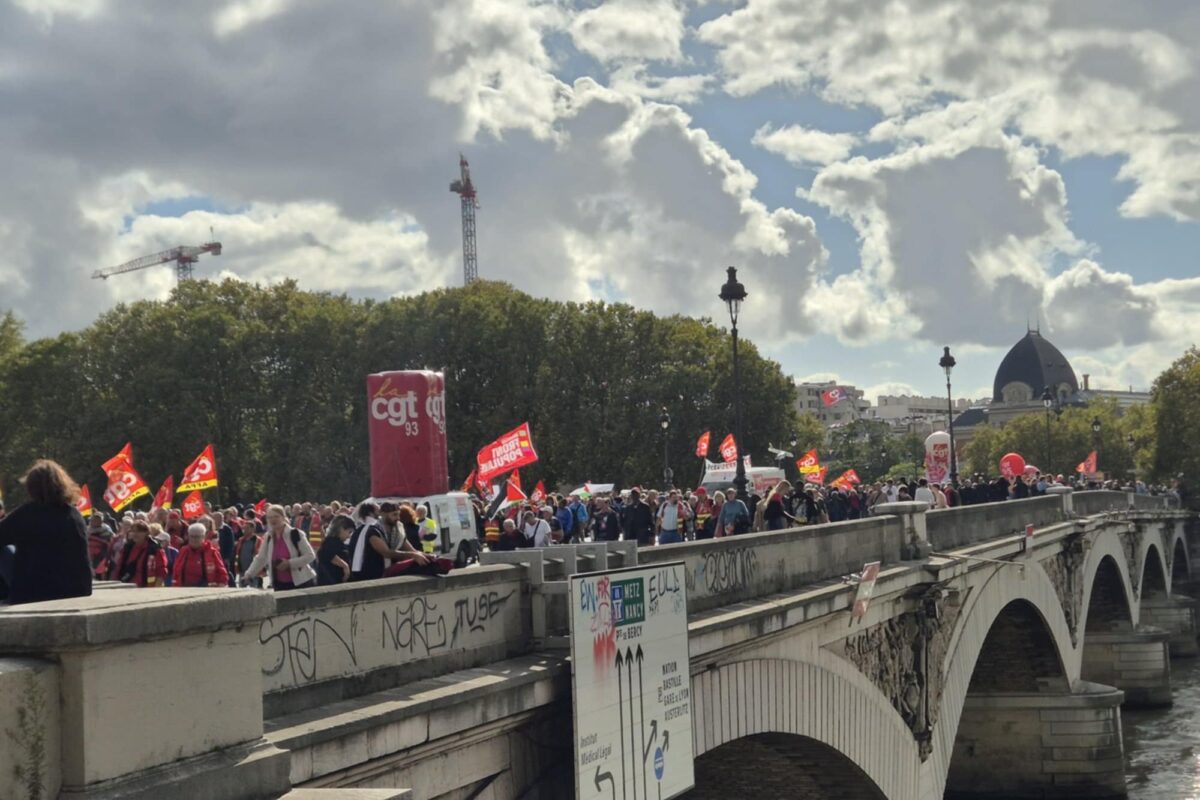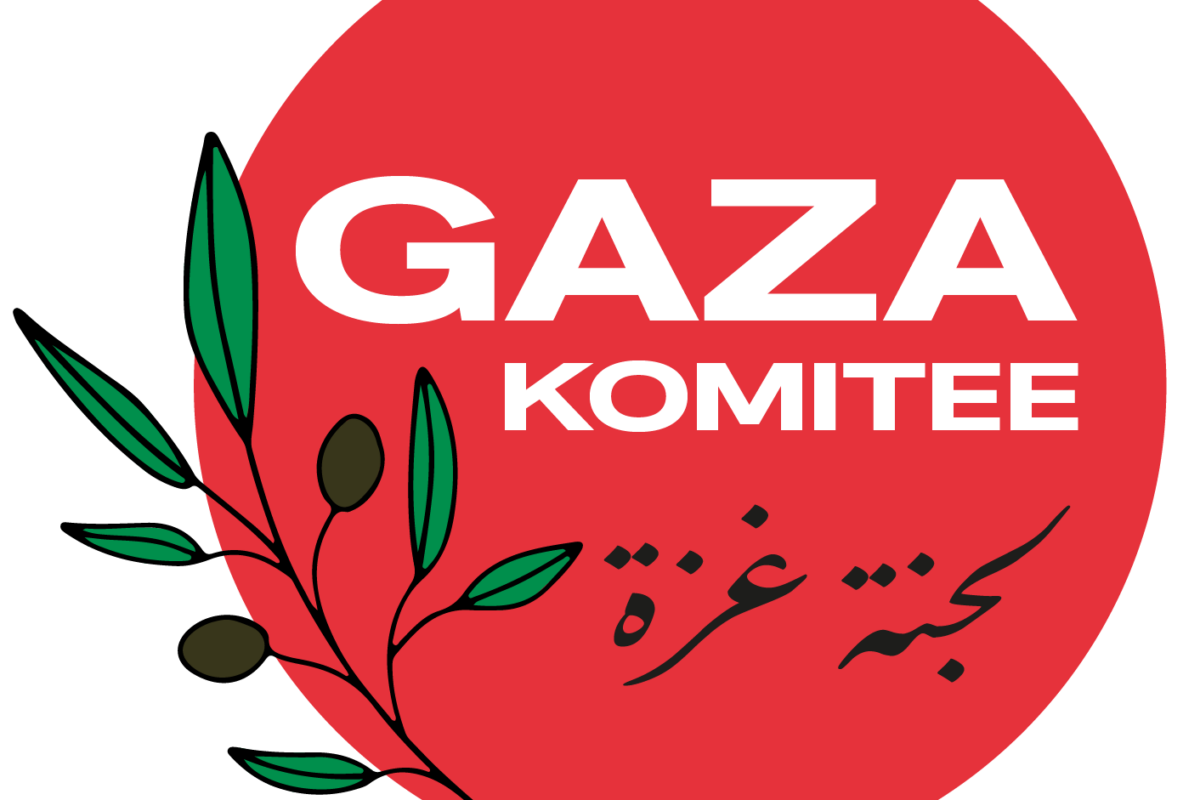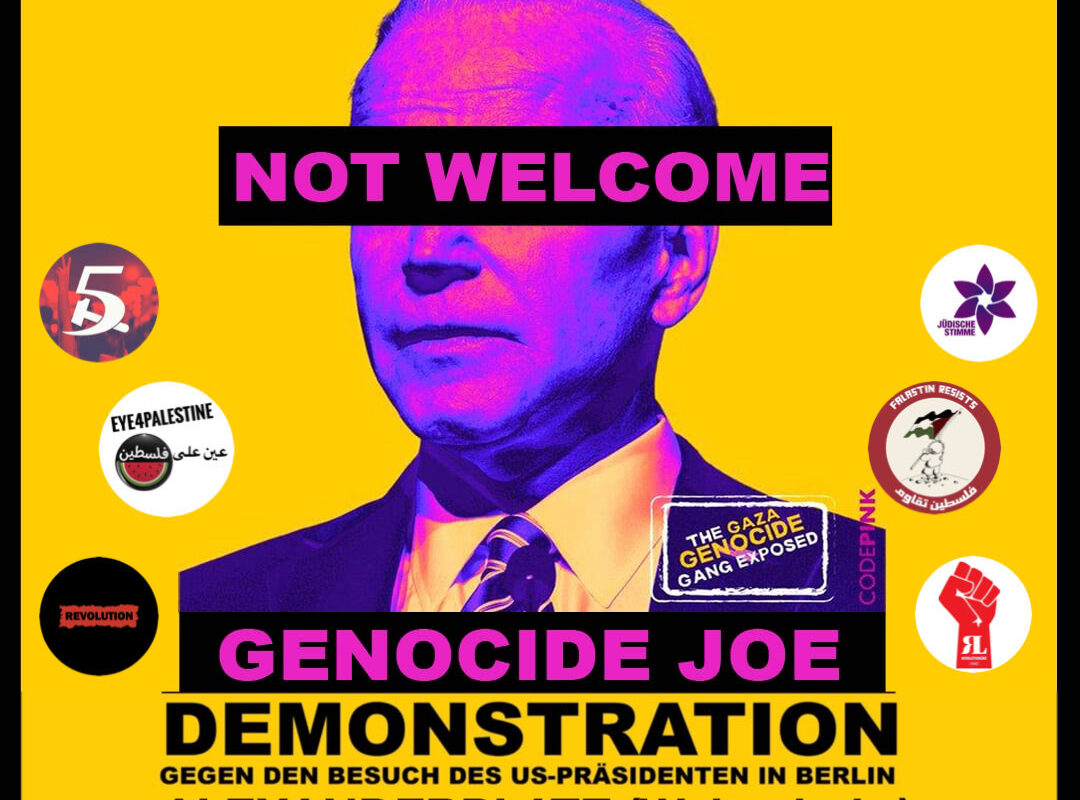In 2002, Polish artist Jonna Rajkowska created Greetings From Jerusalem Avenue, a huge artificial palm tree in the middle of the busy roundabout at Warsaw’s Aleje Jerozolimskie. The palm was planned as a temporary project, but has remained for over twenty years, becoming a meeting point for Polish protests ranging from calls to welcome refugees, fight against the abortion ban, join a large-scale nurses’ strike, and solidarity with Palestine.
While the palm is often discussed as an uncanny nod to Warsaw’s 18th century New Jerusalem settlement and former large Jewish population, Rajkowska created it after a visit to Palestine/Israel, reflecting on the intertwinement of Polish, Palestinian, and Jewish traumas. On December 14th, Rajkowska and US-American artist Robert Yerachmiel Sniderman organized a protest action with the help of Grupa Granica at the palm in reaction to the post-October 7th ongoing genocide in Palestine. Holding heatsaving blankets, in reference to the refugees who have been barred from entering Poland’s borders in the past years, with GAZA written on top, they called out: “We stand in solidarity with the Palestinian people being severed from their lives, rights, families, and earth. We say to the Israeli regime and its accomplices: Do not uproot! End the genocide!” Read the full text here.
In this interview, Sarah Adler asks the two artists about the relevance of their action in a German context, especially in light of the recent scandal surrounding Masha Gessen’s comparison of the Warsaw Ghetto with Gaza — as a ghetto being liquidated. They reflect on the triangulation of Palestinian, Jewish, and Polish trauma in this particular project and their wider artistic practices, underlining a shared urgency of a broader critique of the historical and ongoing violence of the ethno-national state. This interview has been edited for length and clarity.
When I came across this project on Instagram, I was really intrigued. What was the inspiration for the recent protest action that the two of you did at the palm?
Joanna Rajkowska (JR): We felt a really pressing urgency to do something. From my perspective, I feel this tree is a major prop on the city stage, overlooking the 24-hour city spectacle. It therefore has some responsibilities. We met about a month earlier and just decided that the tree has to make a declaration of some kind about the genocide in Gaza, that it mustn’t stay silent. Then we discussed words around it, what it should contain, in what direction to go. I am really dismayed that there is no proper, mainstream media discussion in Poland about what is going on in Palestine.
What is the narrative right now in Poland about Palestine?
JR: It almost doesn’t exist and this is shameful. It’s overshadowed by current political events – the war in Ukraine and the Polish post-election euphoria. The major narrative about Israeli-Palestinian conflict is based on the simplistic, and falsely symmetrical juxtaposition: the Hamas terrorists, and the always-touted right to defend on the Israeli side, all backed up by the very palpable Holocaust memory. Of course there are some nuances and doubts but they don’t touch the core of the problem. What is shocking is that the right-wing press is actually quite active in voicing these doubts. What was traditionally a centre-left or neoliberal voice now stays silent or rigs the information in a way that portrays Israel as a supreme ethical power that needs to tame the savages.
We need to remember that Poland is going through a process of looking at its own position in the Holocaust. It is still a very fresh and open wound, a very fresh sense of guilt, not like in Germany, where it is almost cemented as part of the national identity. To see the conflict clearly, as two consequential genocides (Holocaust leading to Nakba 1948 – and then Nakba 2023), it needs time and reflection.
Robert Yerachmiel Sniderman (RYS): Maybe it’s important to say that, distinct from the postwar German context, as far as I understand, the broad Polish Left continues to include important Polish Jewish figures like Adam Michnik and Konstanty Gerbert, who both work for the Warsaw daily, Gazeta Wyborcza, and have contributed immensely to humanitarian and democratic dissent since their involvement in the Solidarity movement. Such figures, as well as the few official Jewish institutions in Poland, avoid critique of or endorse Israeli war crimes. Festivalt, a Jewish-led platform for art and activism, remains an exception, having released a statement condemning the Israeli response to October 7th while highlighting its collaboration with Jenin’s Freedom Theatre, which as we speak is trying to survive raids, arrests, and destruction. Then, the Polish Right, in many cases, is simply anti-Jewish. It is against the State of Israel as a Jewish collective and frames the genocide as evidence for inherent Jewish corruption. For instance, administrators in the city of Chrzanów just delayed a public action for Esther’s Willow, a project I co-direct, until after regional elections, as our act, the marking of a former Jewish square, will be used against those holding office.
Was your recent action an attempt to intervene in this debate, to add some kind of different perspective?
JR: We really wanted to shake the chaotic, patchy, unreliable, and skewed images emerging in Poland about what is going on in Gaza and the West Bank. Since the phrase “never again” doesn’t have the resonance here that it does in Germany, I thought: what if we get to the core of the conflict, which is about the land. I was thinking about uprooting, a severed and cut connection to the land, which is the fundamental problem of the situation, one shared by both peoples. The Europeans uprooted the European Jews and started the whole catastrophic chain of events. It is ongoing in Palestine, where the same crime is being reproduced. We thought “do not uproot”, “nie wykorzeniaj” in Polish, would be the key to understanding the tree’s declaration.
…what is happening in Palestine/Israel is not merely another instantiation of oppression that all nation-states integrally manifest, but part of a specific and specifically unresolved logic of annihilation.
What resonances does your recent action have in a German context? I am thinking especially of the recent controversy surrounding Masha Gessen. The crux of the current debate surrounds Gessen’s comparison of the liquidation of the Warsaw Ghetto with Gaza as a ghetto being liquidated, bringing up questions of interconnectedness and comparison of Palestinian, Jewish, and Polish traumas.
JR: Masha Gessen’s recent article was a revelation for me. I think the German perspective on the Holocaust is extremely limited in the sense that it is compartmentalized. Perhaps an action in Warsaw that directly refers to this error would hit at its core. Maybe it will work as, like Robert says, a triangulation of this problem. It should always be seen in a broader context and not as a German problem, or the German problem. It’s a Polish problem too, it has so many faces and shades. An action in Warsaw gives it a completely different tint. The Polish approach is a lot more visceral, physical, because the Holocaust crimes happened mainly here. Right here on this soil. It will always be a major subject not just in public debate, but in a perpetual cycle of history, which is an organic process. Remembering is different if it refers to physically distant soil, in the absence of organic remains, of places, of forests, under a different sky, under a different angle of light. Really, the Holocaust here comes into every conversation about the past, as an absolute ground zero point. If we included this type of physicality of memory, the life cycle of memory into the dry German view, perhaps something would change. Robert’s text very much includes this kind of organic feature of remembering – or perhaps more of a bodily reaction to the conditions of murder.
RYS: The Israeli regime has crossed an irreversible line and it promised this crossing immediately after the massacre on October 7th. At this point, there are 1.9 million people displaced, two-thirds of Gaza’s built environment in ruins, over 20,000 people murdered. In my earlier project about Gaza and Holocaust memory, Counter-Ruin (2018), I implicitly linked the Warsaw Ghetto with Gaza, in a visceral, intuitive movement—not dissimilar from DO NOT UPROOT.
In response to a massacre of demonstrators in the Great March of Return, I walked 16 kilometers across Berlin with a rusted-off car exhaust pipe tied to my abdomen, the word GAZA painted across my back, and 13 stones I had collected in the streets of Warsaw piled on one hand. Like the Great March of Return, I think I enacted this piece, the first of three such walks, as a warning — but to Europeans who live in the ruins of anti-Jewish genocide, and to myself. Like the walkers in the Great March of Return, I was trying to draw and walk my own line—a line that says what is happening in Palestine/Israel is not merely another instantiation of oppression that all nation-states integrally manifest, but part of a specific and specifically unresolved logic of annihilation. Europe depends upon the State of Israel as restitution. And it was not restitution. It was, and remains, a perpetuation of our persecution; a mere gift of the weapon.
DO NOT UPROOT announces this position at another, more dire, and this time irreversible moment. It announces, from the position of Warsaw — holy Warsaw! — and everything that Warsaw means to the planet, a new era has commenced, and it is time for a too-long averted restitution of the logic of annihilation. Projects I was learning from at the time, like Dor Guez’s book, Al-Lydd, explicitly averted these relations. Joanna did not. And this is why we have come to work together.
JR: There is a difference between the view from above, the perspective of knowledge and power and the view from below, on a bodily level — a labyrinth, a barricade. I did a project last year called SORRY, an anti-monument, based on this difference. The wall folds itself into letters: S, O, R, R, Y. This makes me think of the German perspective in the sense that it is just an urge to protect a chosen group of people, an urge that is singled out and isolated from the cause and effect sequence. No matter that the Nazi strategies are reproduced. Germany found itself exactly in the same place on a spiral of history. In a different configuration and different context, but the same algorithm is being deployed. With the same problem: there is no bodily level involved, it is just a view from above. Bringing it down to the level of the body is important — hence we used life-saving thermal blankets as flags in our performance. And this is why we used the tree as a figure of this completely different understanding of how we belong to the land. How land produces us as much as it produces trees and other forms of life. How it produces cultures. Reversing the view might change the ethno-nationalist understanding of that very mechanistic, in the sense of what Masha Gessen describes, perspective or paradox of the reproduction of evil.
This seems linked to the text Robert wrote for DO NOT UPROOT in its call not just against the uprooting of particular peoples, but against a broader violence being enacted by the political form of the nation-state.
RYS: In the wake of the October 7th massacre and the machination of this genocide, I felt an exhausted internal political stasis break open. In the short DO NOT UPROOT text, I try to distil what I’ve come to think through the influences of mentors like Joanna, Dirar Kalash, A.S. Bruckstein Çoruh and my recent humble participation in the Kurdish struggle in Rojava, Bakur, and Rojhelat. When in our text, I write, the nation-state is premised on “depopulation, suicidal militarism and racist borders,” I am trying to say our planetary conditions necessitate more than pure resistance to imperialism, war crimes, or settler-colonialism. When the overwhelming structure of nation-states are more often premised on identitarian divisions created themselves by modern territories that claim eternal genealogies; where refugees, exploited workers, silenced poets, and peasants are pitted in a life-death struggle against the descendants of refugees, exploited workers, silenced poets, and peasants amidst broad trans-generational erasures of inconvenient heterogenous languages, cosmologies, and relations.
Warsaw’s palm and the Kurdish anti-statist proposal for universalist, ecofeminist, democratic confederalisms that empower local cultures in tandem and listen foremost to the needs of the land and water are planetary gifts to our shared, messy and more-than-human struggle to survive with dignity and consent. The Kurdish theorist-activist Nastaran Saremy and I call this “imagined land”. Relations to place erupt from particular moments in the land, by way of translocal imaginations and temporal sovereignties. Territorial boundaries have nothing to do with such eruptions. Absolute borders do not mark place, but domination. The palm is a monument to such an eruption, which is why in the nation-state of Poland, it is considered an anti-monument. Nastaran says, “It lives in imagined land.”
Contemporary post-war Polish identity is based on a void in one way or another. During Communism the Jewish fate was diluted by the trauma of the second world war tragedy, which was palpable in every Polish family, whether Jewish or not… the tree is not about a chosen fragment of Polish-Jewish history, but about a principle embedded and repeated in European history that reproduces endless catastrophes on a global scale.
It’s interesting to think of this as a prompt to ask what free Palestine means now, how to keep this from turning into the call for another ethno-national state, how to think of different configurations. It also brings up the memory of Palestine embedded in the tree itself. Often when the palm is discussed, it is seen as bringing the memory of both Jewish life and Israel back to Poland, but how was it also rooted in Joanna’s experience of Palestine and the Second Intifada?
JR: The palm was never supposed to be a completed statement. It was a doubt, a lack of comprehension, unthinkability, a lack of solutions, visions. It’s about conflict that is an abyss. When I went to Palestine for the first time, in 2001, there was a pure fear and tension there that I sensed with my entire body. I was not able to sleep. I remember being in East Jerusalem during the Second Intifada and smelling the stress sweat in the air, hearing the distant sound of shelling in Bethlehem. My image of Israel was based on that anxiety. At the same time, I realized that if I were one of them, the new Israelis in the forties, I would have come, gone through the same trajectory from enthusiasm, kibbutz, labor, ambivalence, to disappointment. It seemed to be unavoidable. When I came back to Warsaw, I deeply felt the void. Jerusalem Avenue seemed to be completely deserted, it needed something, a sign in which this void would culminate and be transformed. It wasn’t a political statement — but, of course, at the core it was fundamentally political in terms of connection to the land, it was anti-Zionist as much as a tree can be. The inner structure of the palm tree is that it is completely empty, a frame without content. The frame was the history of Jerusalem Avenue. It’s deeply symbolic that this existed invisibly, undetected in the city background.
Contemporary post-war Polish identity is based on a void in one way or another. During Communism the Jewish fate was diluted by the trauma of the second world war tragedy, which was palpable in every Polish family, whether Jewish or not. But the loss was generalized in an unhealthy way. I know it sounds like heresy and I don’t want to compare the traumas. The proper debate exploded after 1989 with such a force that no other issues were admitted into that explosion. The palm tree was put up in 2002, so still at a pretty early stage in the post-transformation time. And my generation was the first to take it onboard. It couldn’t really include dialogue around Israel and Palestine at the time — this is why I mention 2011, when pro-Palestinian activists put a keffiyeh on the tree’s trunk and the issue became really apparent, and 2023 with the genocide in Gaza. The gravity of it transformed the original “frame” as I described it earlier. It became apparent that the tree is not about a chosen fragment of Polish-Jewish history, but about a principle embedded and repeated in European history that reproduces endless catastrophes on a global scale. It is simply about the traumatic consequences of the European project.
Joanna, one of your works, Camping Jenin (2008), a collaboration with Freedom Theatre in the Jenin refugee camp, had a lot of interesting parallels to this because it departed from Oxegenator (2007), a project that took place in the site of the former Jewish ghetto in Warsaw. It was a project about reimagining experiences of trauma and how they resonate as a bodily experience. How are these resonances playing out in how you or the tree deals with Jewish and Palestinian trauma in a Polish space?
JR: My idea was that people would experience history and trauma in a way that would avoid using language, therefore freeing it from the structures that language imposes. Oxygenator was a pond with a cloud of oxygenated air hovering over it, but more importantly it was a place to breathe and synchronize breathing with the rhythm of pulsating life around. We knew exactly what kind of ground we were dealing with, how the layers of rubble are mixed with the soil. This was a profoundly physical project — like killing a vampire, putting a stake in its heart. At the same time, it sought to create this living layer on the top of dead rubble, stoked by the life cycles of plants, fish, all beings who were there in the soil, water, and us. To my shock, this was completely understood. People were mesmerised and would sit there for hours. On this land that, as one of the elderly women put it, was literally bathed in blood, every square centimetre traumatised. Where Marek Edelman, a major figure in the Warsaw ghetto uprising, an anti-Zionist, Bund leader, slept in a bunker on the edge of the square.
I went to Freedom Theatre in Jenin with this uplifting hope that if it worked in Poland, it must work in Palestine, which was a little bit naïve. I tripped over my lack of psychological education in a sense, that fresh trauma is not past trauma. I worked with teenagers, boys, who went through the horror of the 2002 Israeli invasion on the Jenin refugee camp. And it was only six years prior to my arrival. They were in a horrible state. The ongoing Israeli harassment which overshadows life in the West Bank on a daily basis doesn’t allow anything to heal. Every minute you are reminded that you are under occupation, controlled, limited, that you have no future. The IDF’s presence strategy is felt at every point. Frankly, it makes me smile when I am reading about the Israeli anxiety, which is incomparable to Palestinian anxiety — it is not even an anxiety, it is simply despair. You live in a constant paralyzing fear that slowly changes you. I was trying to work with that using fiction, to transcend the boys into a space of possibilities, imagination, fairy tales. That was welcome. They didn’t want to stay in reality and face their own trauma or abstract it out. The Oxygenator strategy worked only partially. It was a very different type of trauma, not a scar tissue but an open wound. I was trying to be as careful as possible but I made many mistakes. Luckily I wasn’t alone, I worked with Nabeel al Raee and he was a very good advisor.
It’s also interesting how these projects sit within your broader practice, especially the unrealized Minaret project (2009 – 2011) as a counterpoint to the palm. Robert, you have already mentioned your work Counter-Ruin (2018). You came from Warsaw to Berlin and did an artistic action reacting to the Great March of Return on May 14th, 2018 when 62 Palestinian protesters in Gaza were massacred. You walked from different sites of and monuments to Jewish death to the Israeli embassy, US embassy, Sonnenalle, picking up and placing stones (traditionally laid upon graves as a symbol of remembrance of and respect for the dead in Judaism). Do you see connections to Joanna’s works?
RYS: There are many fundamental connections. The series of three Gaza walks, Counter-Ruin, was created as the public culmination of a long term project called Lost in Jüdischer Friedhof Weissensee (2018), which was influenced by Joanna’s Basia (2009), in which she enacted her then recently deceased mother’s dreamed-of escape from hospital incarceration for progressive psychosis and Alzheimer’s. Around the time I read about this piece, I found myself thinking I had become locked while lost in Berlin’s Jüdischer Friedhof Weissensee, the largest intact and active Jewish cemetery in postwar-Europe. It was the first time in Germany that I spatially dwelled in an uninterrupted community of Jewish generations, from the 19th century to the present, created by Jews themselves and their dead, not artists, museums, or city officials reflecting on a mythology of presence. Basia gave me the idea, indeed the muscle, to reenact a situation that was fervently, necessarily, imagined but which never happened, because the repercussions of such imagining were deeply telling, politicising, and poetic. The ensuing durational performance of being lost in and devoted to this cemetery for six months would envelope my reality. The place became one in which while there I had no choice but to ask myself impossible and fundamental questions about Jewish political existence and otherwise in the contemporary moment.
…these suicides were people who in a desperate way refused to leave, could not leave, their imagined land, and I felt something of the Palestinian struggle in this desperate refusal, as well as the messy impossibility, the labyrinth, of this lineation of our catastrophes.
While working with/in the cemetery, I traveled to Warsaw to meet Joanna and be in the city where my great-grandmother was born. The Great March of Return had begun in Gaza and I was seeing it peripherally, unable to face it. Returning by train from Warsaw to Berlin, it was reported that 62 Palestinians had walked to the Gaza fence, the one broken open on October 7th, and were massacred by IDF snipers. I envisioned walking from the ruins of Anhalter Bahnhof, a Nazi deportation site, to the cemetery, placing stones I had collected in Warsaw, on the graves of the many thousand Jewish Berliners who had committed suicide in 1942, during the onset of mandatory deportations for all the city’s Jews.
Why did it feel important to focus specifically on these suicides at first?
RYS: I’m not sure why, and I’m still working this out, I fixated on these suicides, and wanted to link them to Palestinian rights of return and ghettoisation. Perhaps because it had been an honourable, if heretical, transgression of that institution’s norms to bury suicides, and that I learned from it something about manifesting urgent intra-Jewish transgression in a time of need. And because more than any others, these suicides were people who in a desperate way refused to leave, could not leave, their imagined land, and I felt something of the Palestinian struggle in this desperate refusal, as well as the messy impossibility, the labyrinth, of this lineation of our catastrophes. I enacted a slightly revised form of this vision, wherein I also crossed places like the Israeli Embassy, the US embassy (where I intentionally spilled and painstakingly re-gathered my Warsaw stones in front of its police guards), the Memorial to the Murdered Jews of Europe, and Sonnenallee, which is probably the largest Palestinian commercial district in Europe.
Thank you both for sharing your thoughts today! Any final words from both of you?
JR: Perhaps, from my side, I hope DO NOT UPROOT becomes an obvious phrase. We need to think through the living tissue of all the organisms around us to be able to reinvent our political and social structures.
RYS: Yes, imagine land.
